Sir John Monash, Personal Files Book 12, 3 April - 30 April 1916, Part 1
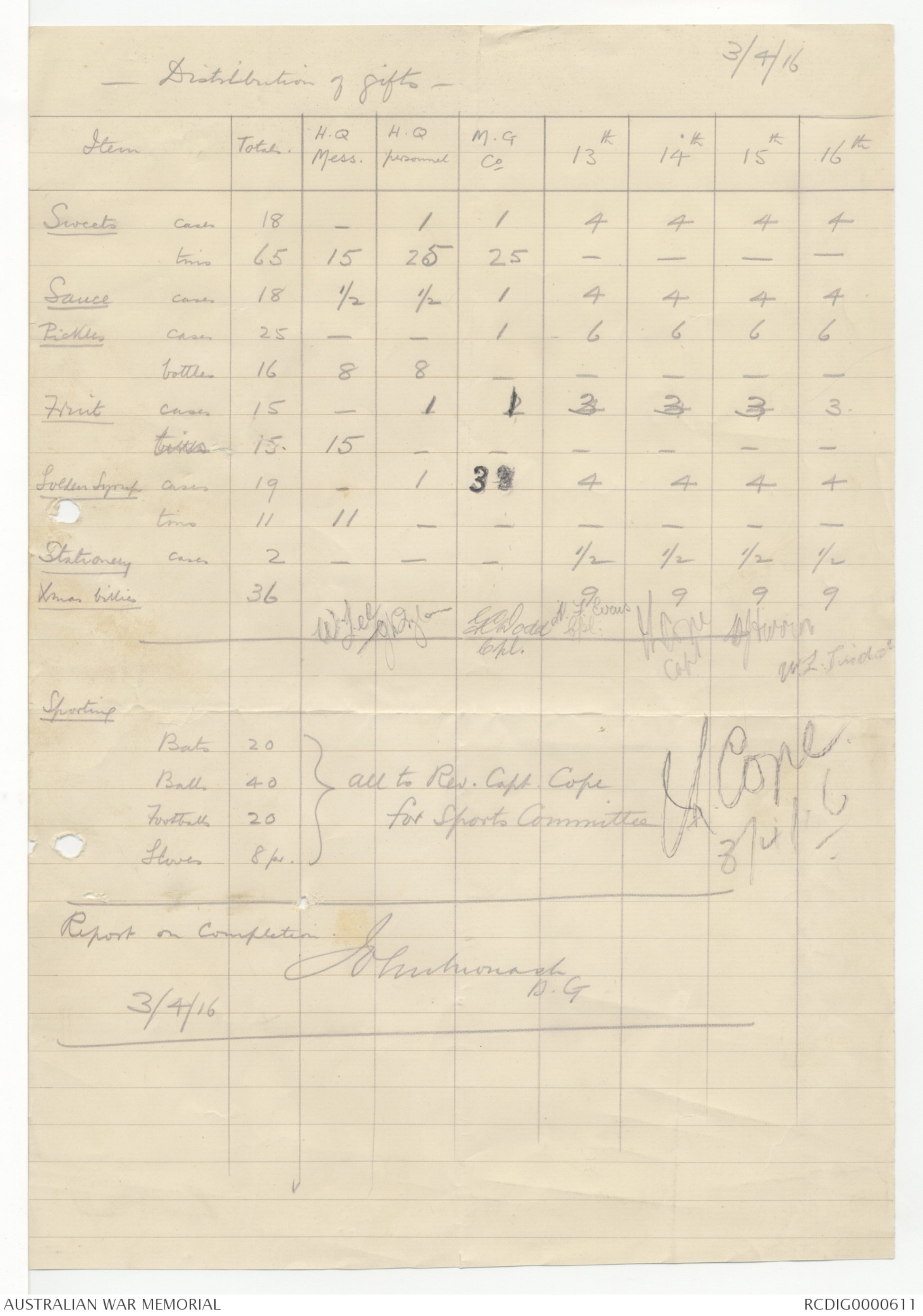
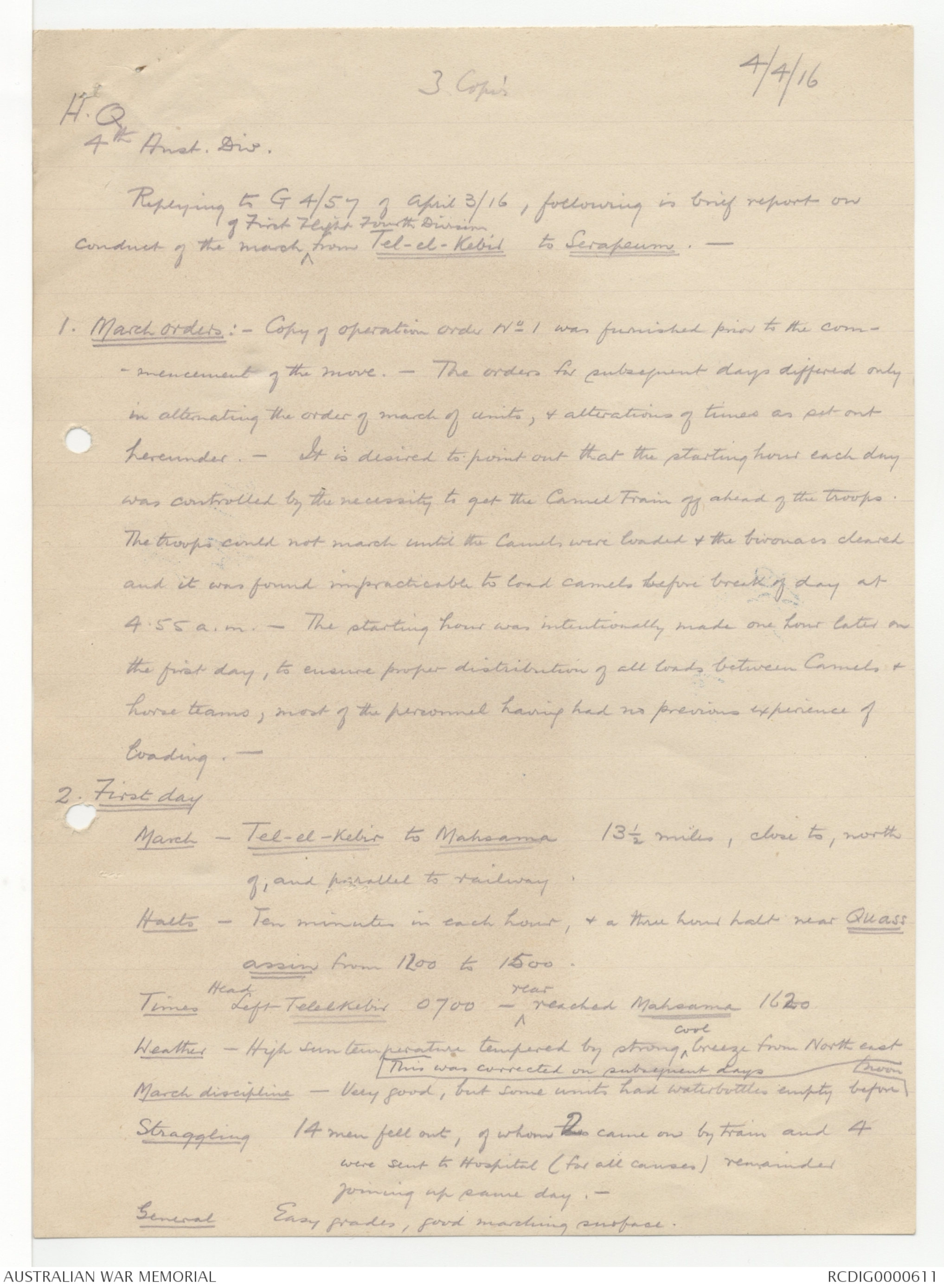
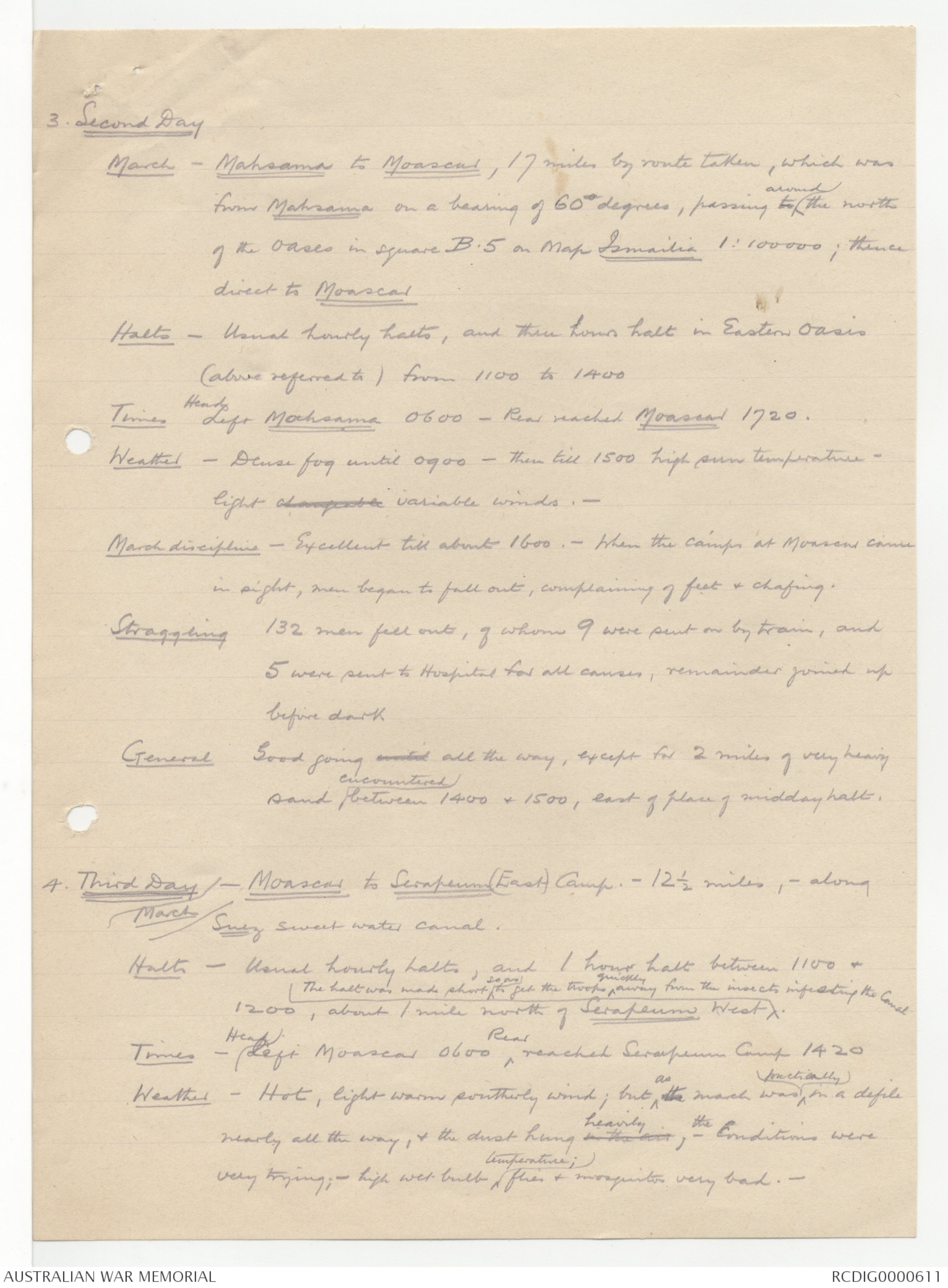
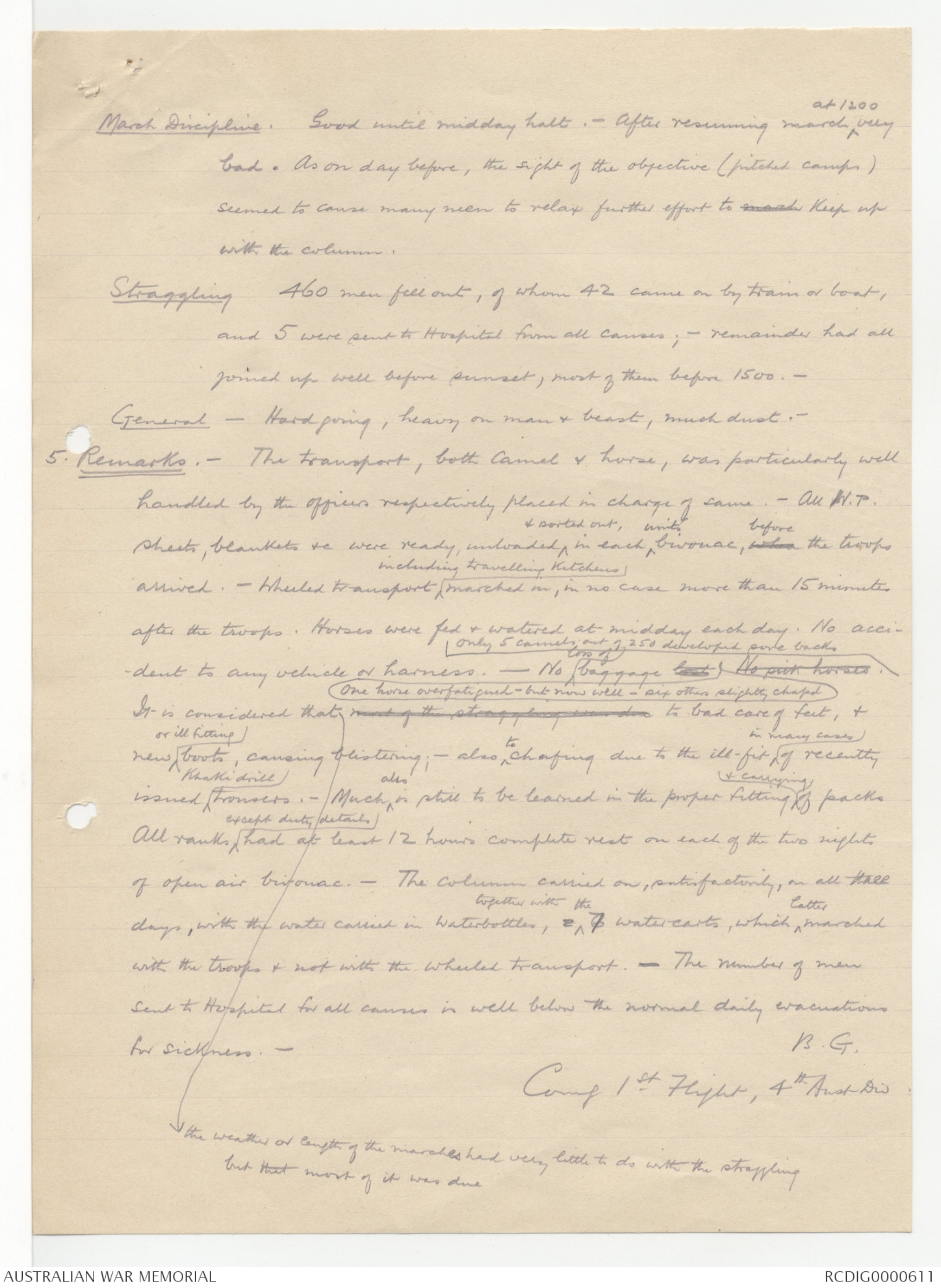
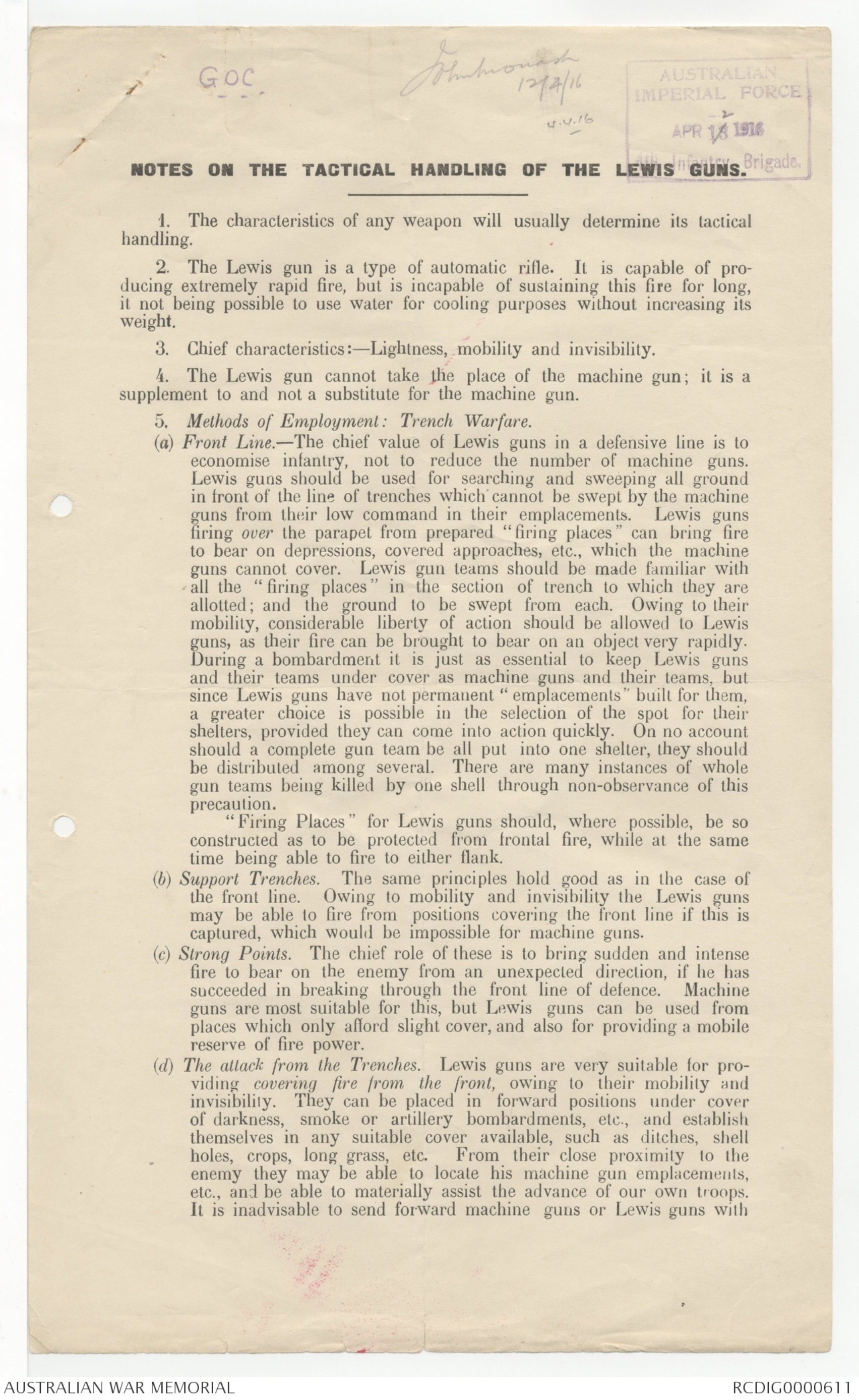
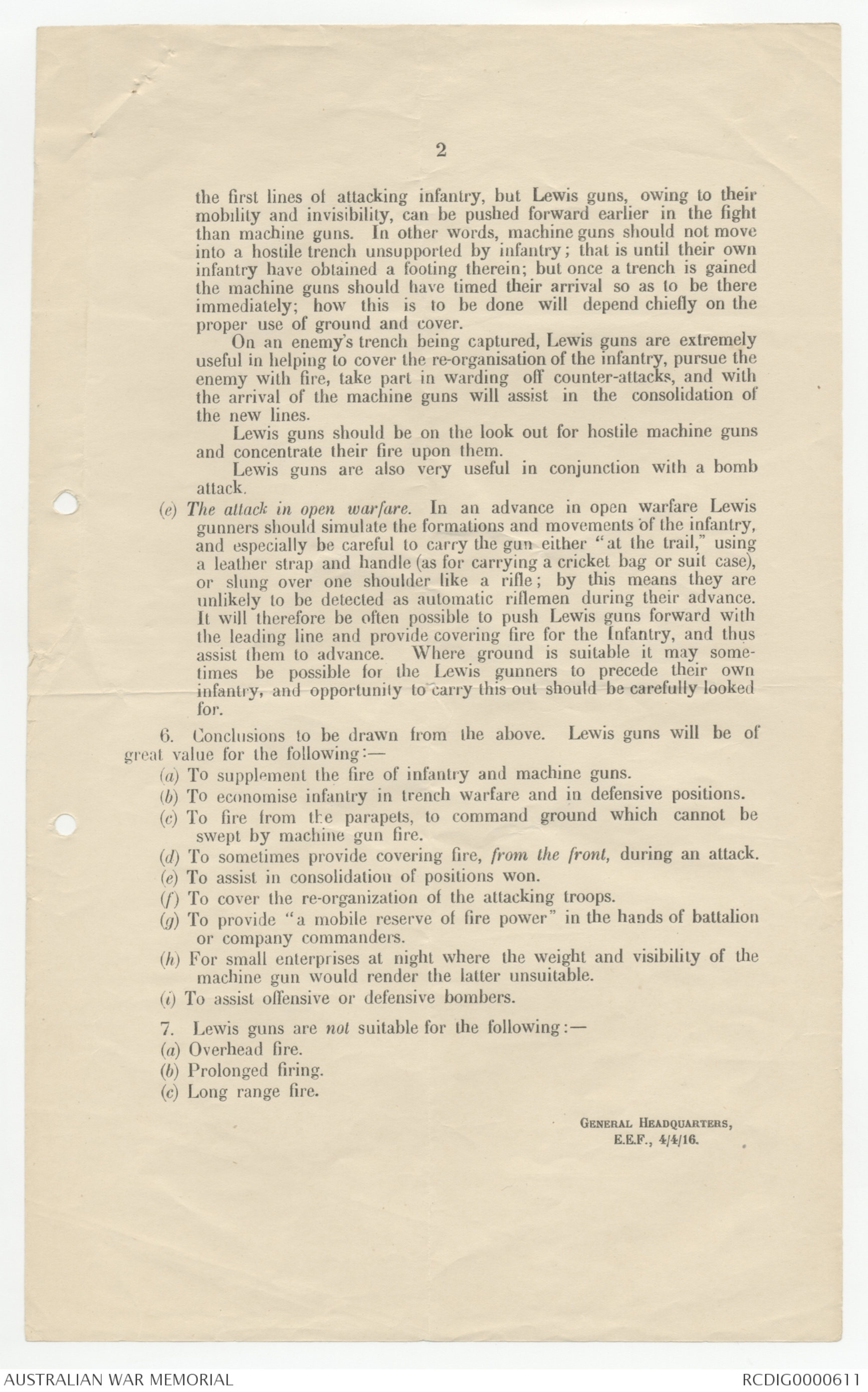
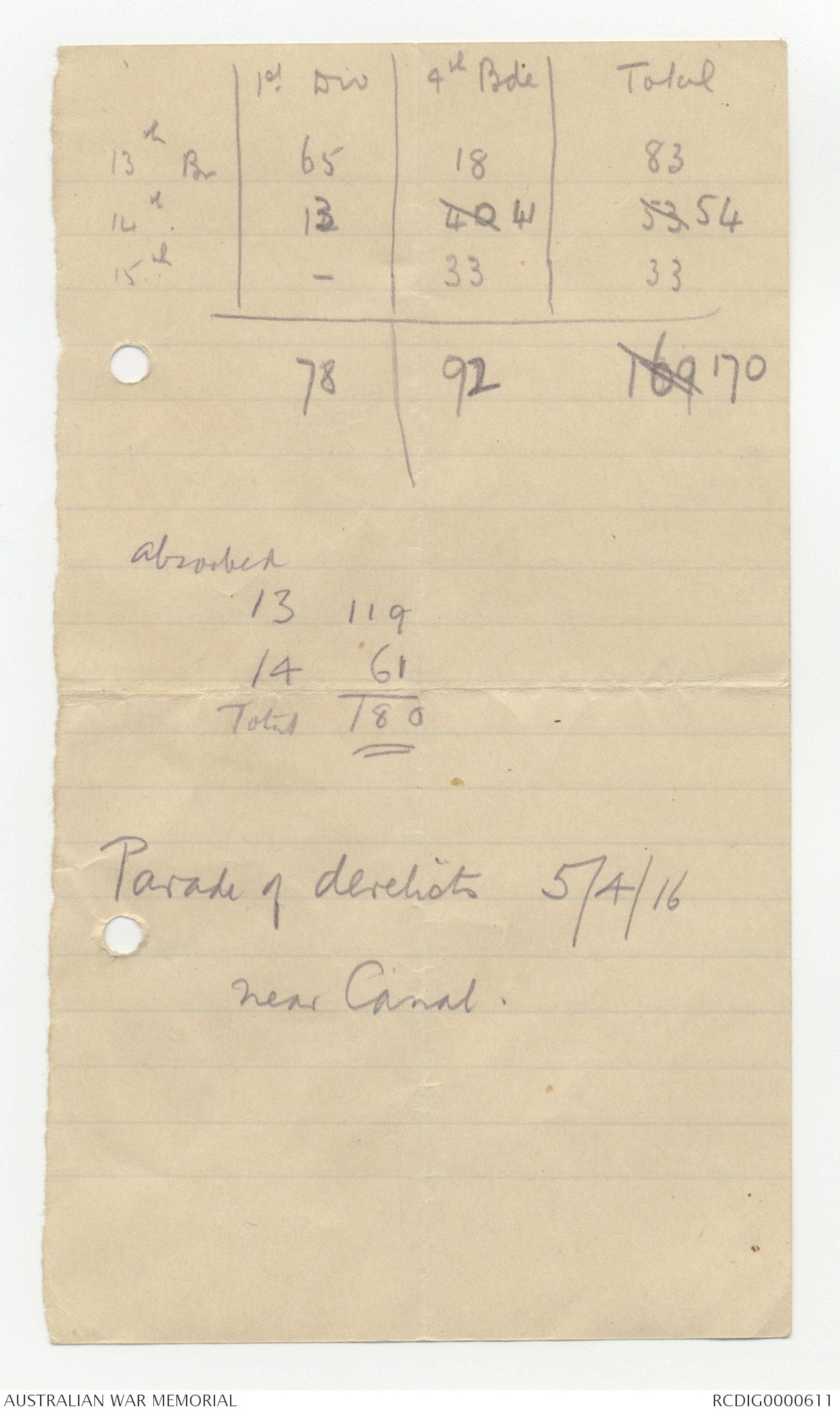
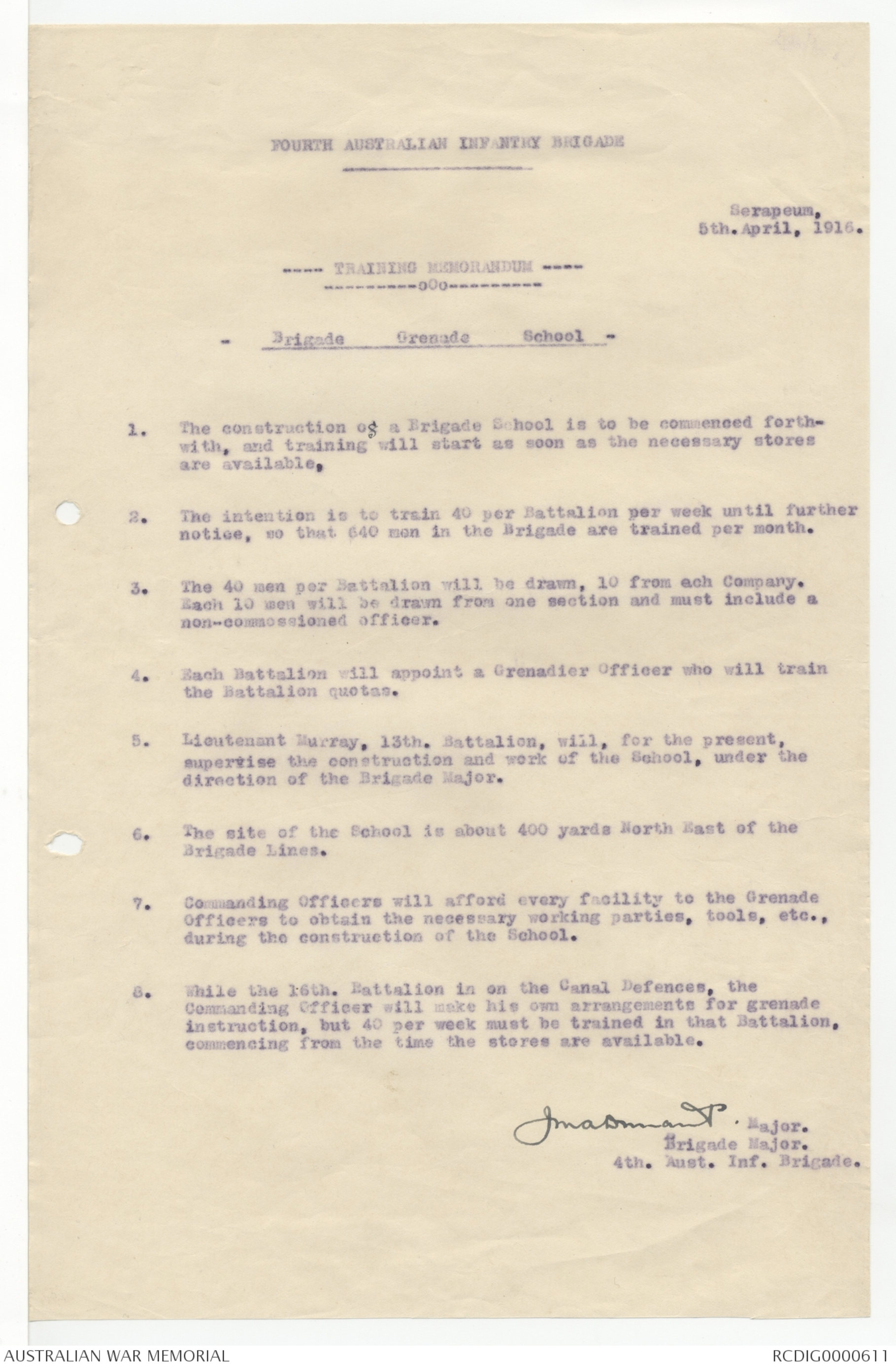
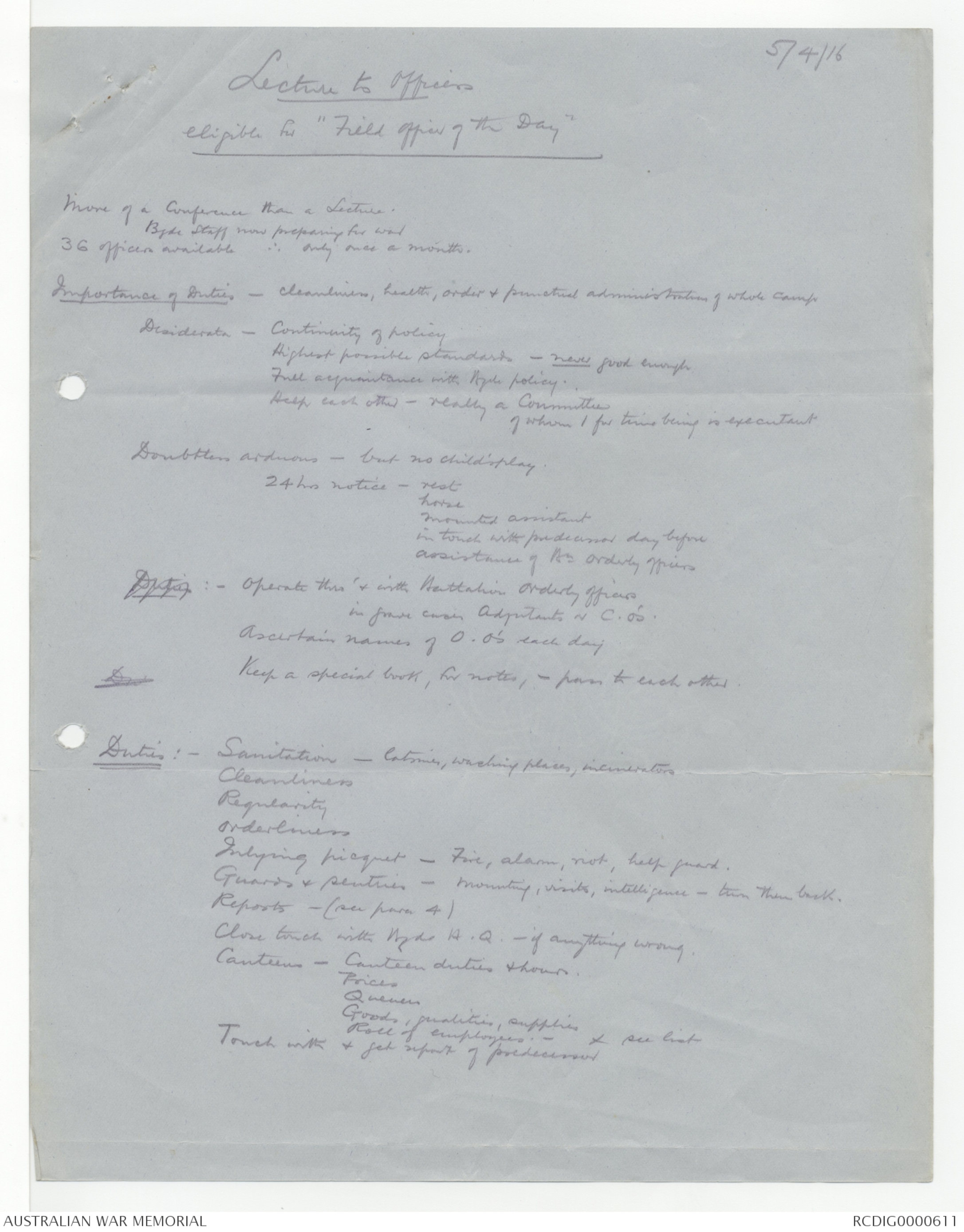
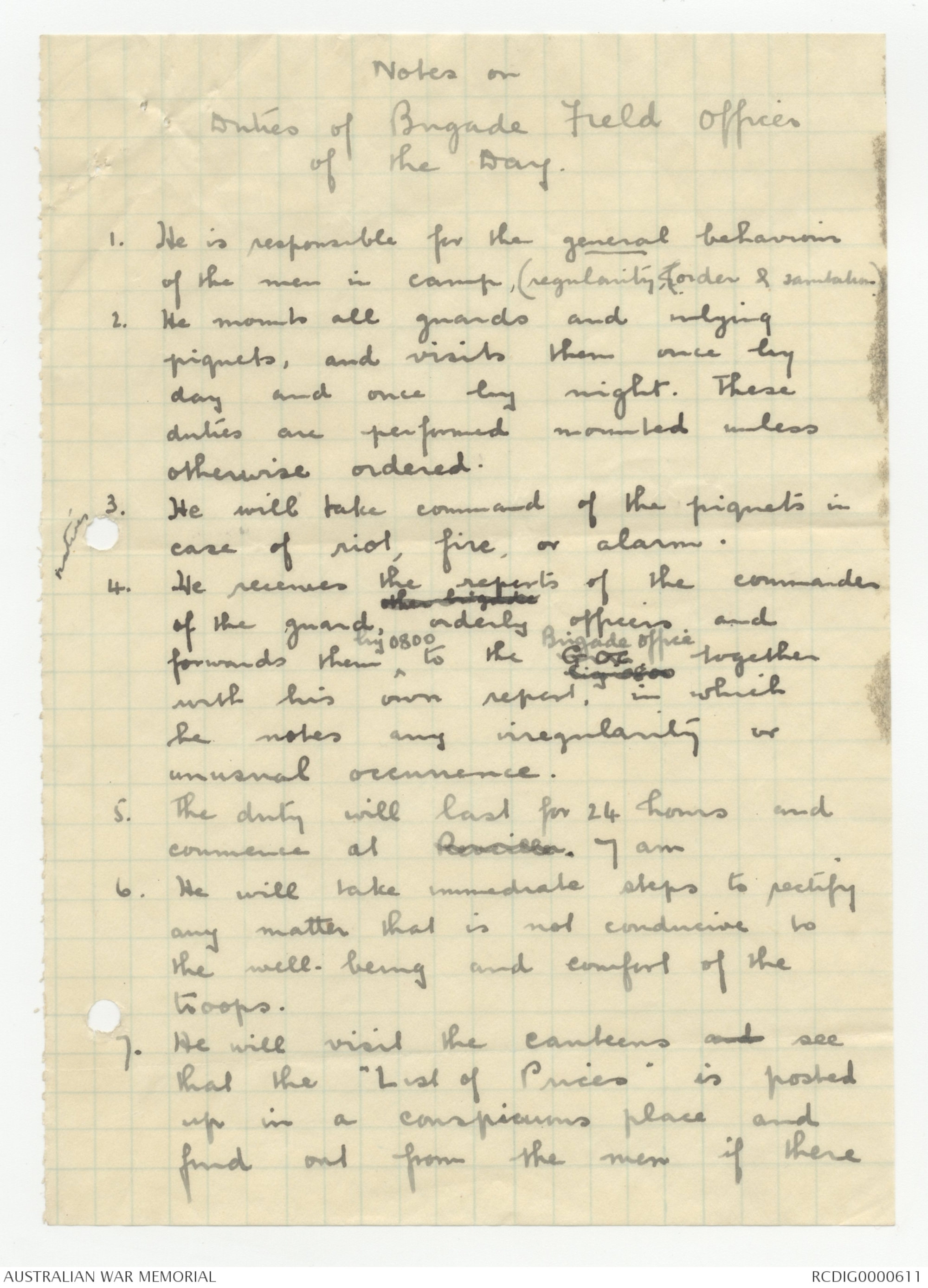
3/4/16
-Distribution of gifts -
| Item | Totals | H.Q Mess. | H.Q Personnel | M.G Co | 13th | 14th | 15th | 16th | |
| Sweets | cases |
18 |
- |
1 |
1 |
4 |
4 |
4 |
4 |
| tins |
65 |
15 |
2 |
25 |
- |
- |
- |
- |
|
| Sauce | cases |
18 |
½ |
½ |
1 |
4 |
4 |
4 |
4 |
| Pickle | cases |
25 |
- |
- |
1 |
6 |
6 |
6 |
6 |
| bottles |
16 |
8 |
8 |
- |
- |
- |
- |
- |
|
| Fruit | cases |
15 |
- |
1 |
|
|
|
|
3 |
| bottles |
15 |
15 |
- |
- |
- |
- |
- |
- |
|
| Golden Syrup | cases |
19 |
- |
1 |
3 |
4 |
4 |
4 |
4 |
| tins |
11 |
11 |
- |
- |
- |
- |
- |
- |
|
| Stationery | cases |
2 |
- |
- |
- |
½ |
½ |
½ |
½ |
| Xmas billies |
36 |
|
|
|
9 |
9 |
9 |
9 |
|
| W Lee | J Dylan | GCDodd Cpl |
N.F. Evans Cpl | JL Cope Capt. | DJ Twain | WL Lindol | |||
| Sporting | |||||||||
| Bats | 20 | } | |||||||
| Balls | 40 | } | all to Rev. Capt. Cope | JL Cope | |||||
| Footballs | 20 | } | for Sports Committee | 03/04/16 | |||||
| Gloves | 8 pr. | } | |||||||
| Report on Completion | John Monash | ||||||||
| 03/04/16 | D.G. | ||||||||
3 Copies
4/4/16
H.Q
4th Aust. Div.
Replying to G 4/57 of April 3/16, following is brief report on
conduct of the march of ^First Flight Fourth Division from Tel-el-Kebir to Serapeum. -
1. March Orders: - Copy of operation order No 1 was furnished prior to the commencement
of the move. - The orders for subsequent days differed only
in alternating the order of march of units, & alterations of times as set out
hereunder. - It is desired to point out that the starting hour each day
was controlled by the necessity to get the Camel Train off ahead of the troops.
The troops could not march until the Camels were loaded & the bivouacs cleared
and it was found impracticable to load camels before breaking day at
4.55a.m. - The starting hour was intentionally made one hour later on
the first day, to ensure proper distribution of all loads between Camels &
horse teams, most of the personnel having had no previous experience of
loading. -
2. First day
March - Tel-el-Kebir to Mahoama 13 ½ miles, close to, north
of, and parallel to railway.
Halts - Ten minutes in each hour, & a three hour halt near Quassassin
from 1200 to 1500.
Times ^Head Left Telelkebir 0700 - ^rear reached Mahsama 1620
Weather - High sun temperature tempered by strong ^cool breeze from North east
^This was corrected on subsequent days
March discipline - Very good, but some units had waterbottles empty before ^noon
Straggling 14 men fell out, of whom 2 came on by train and 4
were sent to Hospital (for all causes) remainder
joining up same day. -
General Easy grades, good marching surface.
Second Day
3. Second Day
March - Mahsama to Moascar, 17 miles by route taken, which was
from Mahsama on a bearing of 60°degrees, passing to ^around the north
of the oasis in square B.5 on map Ismailia 1:100000; thence
direct to Moascar
Halts - Usual hourly halts, and three hours halt in Eastern Oasis
(above referred to) from 1100 to 1400
Times - ^Head Left Mahsama 0600 - Rear reached Moascar 1720.
Weather - Dense fog until 0900 - then till 1500 high sun temperature -
light changeable variable winds.
March discipline - Excellent till about 1600. - then the camps at Moascar came
in sight, men began to fall out, complaining of feet and chafing.
Straggling - 132 men fell out, of whom 9 were sent on by train, and
5 were sent to Hospital for all causes, remainder joined up
before dark
General Good going xxxx all the way, except for 2 miles of very heavy
sand ^encountered between 1400 & 1500, east of place of midday halt.
4. Third Day
March - Moascar to Serapeum (East) Camp. - 12 ½ mils, - along
Suez sweet water canal.
Halts - Usual hourly halts, and 1 hour halt between 1100 &
1200, about 1 mile north of Serapeum West.
^The halt was made short ^so as to get the troops ^quickly away from the insects infesting the Canal.
Times - ^Head Left Moascar 0600 ^Rear reached Serapeum Camp 1420
Weather - Hot, light warm southerly wind; but ^as the march was ^practically in a \defile
nearly all the way, & the dust hung ^heavily in the air, -^the Conditions were
very trying; - high wet bulb ^temperature; flies & mosquitos very bad. -
March Discipline. Good until midday halt. - After resuming march ^at 1200 very
bad. As on day before, the sight of the objective (pitched camps)
seemed to cause many men to relax further effort to march Keep up
with the column.
Straggling 460 men fell out, of whom 42 came on by train or boat,
and 5 were sent to Hospital from all causes; - remainder had all
joined up well before sunset, most of them before 1500.-
General - Hard going, heavy on man & beast, much dust. -
5. Remarks. - The transport, both Camel and horse, was particularly well
handled by the officers respectively placed in charge of same. - All W.T.
sheets, blankets etc were ready, unloaded ^& sorted out, in each ^units bivouac, before the troops
arrived. - Wheeled transport ^including travelling Kitchens marched in, in no case more than 15 minutes
after the troops. Horses were fed & watered at midday each day. No accident
to any vehicle or harness. - No ^loss of troop baggage lost No sick horses
^Only 5 camels out of 250 developed sore backs
^One horse overfatigued - but now well - six others slightly chafed.
It is considered that ^ the weather or length of the marches had very little to do with the straggling
but that most of it was due most of the struggling was due to bad care of feet, &
new ^or ill fitting boots, causing blistering; - also ^to chafing due to the ill-fit ^in many cases of recently
issued ^Khaki drill trousers. - March ^also is still to be learned in the proper fitting & carrying of packs
All ranks ^except duty details had at least 12 hours complete rest on each of the two nights
of open air bivouac. - The column carried on, satisfactorily, on all three
days, with the water carried in Waterbottles, ^together with the 7 watercarts, which ^latter marched
with the troops & not with the wheeled transport. - The number of men
sent to Hospital for all causes is well below the normal daily evacuations
for sickness. -
B.G.
Corp 1st Flight, 4th Aust Div.
GOC
J Monash
12/4/16
4.4.16
[*Australian Imperial Force
APR 12 1916
4th Infantry Brigade*]
NOTES ON THE TACTICAL HANDLING OF THE LEWIS GUNS.
1. The characteristics of any weapon will usually determine its tactical
handling.
2. The Lewis gun is a type of automatic rifle. It is capable of producing
extremely rapid fire, but is incapable of sustaining this fire for long,
it not being possible to use water for cooling purposes without increasing its
weight.
3. Chief characteristics:-Lightness, mobility and invisibility.
4. The Lewis gun cannot take the place of the machine gun; it is a
supplement to and not a substitute for the machine gun.
5. Methods of Employment: Trench Warfare
(a)Front Line.-The chief value of Lewis guns in a defensive line is to
economise infantry, not to reduce the number of machine guns.
Lewis guns should be used for searching and sweeping all ground
in front of the line of trenches which cannot be swept by the machine
guns from their low command in their emplacements. Lewis guns
firing over the parapet from prepared "firing places" can bring fire
to bear on depressions, covered approaches, etc., which the machine
guns cannot cover. Lewis gun teams should be made familiar with
all the "firing places" in the section of trench to which they are
allotted; and the ground to be swept from each. Owing to their
mobility, considerable liberty of action should be allowed to Lewis
guns, as their fire can be brought to bear on an object very rapidly.
During a bombardment it is just as essential to keep Lewis guns
and their teams under cover as machine guns and their teams, but
since Lewis guns have not permanent "emplacements" built for them,
a greater choice is possible in the selection for the spot for their
shelters, provided they can come into action quickly. On no account
should a complete gun team be all put into one shelter, they should
be distributed among several. There are many instances of whole
gun teams being killed by one shell through non-observance of this
precaution.
"Firing Places" for Lewis guns should, where possible, be so
constructed as to be protected from frontal fire, while at the same time
being able to fire to either flank.
(b) Support Trenches. The same principles hold good as in the case of
the front line. Owing to mobility and invisibility the Lewis guns
may be able to fire from positions covering the front line if this is
captured, which would be impossible for machine guns.
(c) Strong Points. The chief role of these is to bring sudden and intense
fire to bear on the enemy from an unexpected direction, if he has
succeeded in breaking through the front line of defence. Machine
guns are most suitable for this, but Lewis guns can be used from
places which only afford slight cover, and also for providing a mobile
reserve of fire power.
(d) The attack from the Trenches. Lewis guns are very suitable for providing
covering fire from the front, owing to their mobility and
invisibility. They can be placed in forward positions under cover
of darkness, smoke or artillery bombardments, etc., and establish
themselves in any suitable cover available, such as ditches, shell
holes, crops, long grass, etc. From their close proximity to the
enemy they may be able to located his machine gun emplacements,
etc., and be able to materially assist the advance of our own troops.
It is inadvisable to send forward machine guns or Lewis guns with
2
the first lines of attacking infantry, but Lewis guns, owing to their
mobility and invisibility, can be pushed forward earlier in the fight
than machine guns. In other words, machine guns should not move
into a hostile trench unsupported by infantry; that is until their own
infantry have obtained a footing therein; but once a trench is gained
the machine guns should have timed their arrival so as to be there
immediately; how this is to be done will depend chiefly on the
proper use of ground and cover.
On an enemy's trench being captured, Lewis guns are extremely
useful in helping to cover the re-organisation of the infantry, pursue the
enemy with fire, take part in warding off counter-attacks, and with
the arrival of the machine guns will assist in the consolidation
of the new lines.
Lewis guns should be on the look out for hostile machine guns
and concentrate their fire upon them.
Lewis guns are also very useful in conjunction with a bomb
attack.
(e) The attack in open warfare. In an advance in open warfare Lewis
gunners should simulate the formations and movements of the infantry,
and especially be careful to carry the gun either "at the trail," using
a leather strap and handle (as for carrying a cricket bag or suit case),
or slung over one shoulder like a rifle; by this means they are
unlikely to be detected as automatic riflemen during their advance.
It will therefore be often possible to push Lewis guns forward with
the leading line and provide covering fire for the Infantry, and thus
assist them to advance. Where ground is suitable it may sometimes
be possible for the Lewis gunners to precede their own
infantry, and opportunity to carry this out should be carefully looked
for.
6. Conclusions to be drawn from the above. Lewis guns will be of
great value for the following: -
(a) To supplement the fire of infantry and machine guns.
(b) To economise infantry in trench warfare and in defensive positions.
(c) To fire from the parapets, to command ground which cannot be
swept by machine gun fire.
(d) To sometimes provide covering fire, from the front, during an attack.
(e) To assist in consolidation of positions won.
(f) To cover the re-organization of the attacking troops.
(g) To provide "a mobile reserve of fire power" in the hands of battalion
or company commanders.
(h) For small enterprises at night where the weight and visibility of the
machine gun would render the latter unsuitable.
(i) To assist offensive or defensive bombers.
7. Lewis guns are not suitable for the following:-
(a) Overhead fire.
(b) Prolonged firing.
(c)Long range fire.
GENERAL HEADQUARTERS,
E.E.F., 4/4/16.
| 1st Div | 4th Bde | Total | |
| 13th Bn |
65 |
18 |
83 |
| 14th |
13 |
|
|
| 15th |
- |
33 |
33 |
|
78 |
92 |
|
absorbed
13 119
14 61
Total 180
Parade of derelicts 5/4/16
near Canal.
FOURTH AUSTRALIAN INFANTRY BRIGADE
Serapeum,
5th.April, 1916.
TRAINING MEMORANDUM
Brigade Grenade School
1. The construction of a Brigade School is to be commenced forthwith,
and training will start as soon as the necessary stores
are available.
2. The intention is to train 40 per Battalion per week until further
notice, so that 640 men in the Brigade are trained per month.
3. The 40 men per Battalion will be drawn, 10 from each Company.
Each 10 men will be drawn from one section and must include a
non-commossioned officer.
4. Each Battalion will appoint a Grenadier Officer who will train
the Battalion quotas.
5.Lieutenant Murray, 13th. Battalion, will, for the present,
supervise the construction and work of the School, under the
direction of the Brigade Major.
6. The site of the School is about 400 yards North East of the
Brigade Lines.
7. Commanding Officers will afford every facility to the Grenade
Officers to obtain the necessary working parties, tools, etc.,
during the construction of the school.
8. While the 16th. Battalion is on the Canal Defences, the
Commanding Officer will make his own arrangements for grenade
instruction, but 40 per week must be trained in that Battalion,
commencing from the time the stores are available.
JM Durrant. Major.
Brigade Major.
4th. Aust. Inf. Brigade.
5/4/16
Lecture to Officers
eligible for "Field Officer of the Day"
More of a conference than a Lecture.
Bgde Staff now preparing for war
36 officers available ∴ only once a month.
Importance of Duties - cleanliness, health, order & punctual administration of whole camp
Desiderata - Continuity of policy
Highest possible standards - never good enough
Full acquaintance with Bgde policy.
Help each other - really a Committee
of whom I for time being is executant
Doubtless arduous - but no child'splay.
24 hrs notice - rest
horse
mounted assistant
in trench with predecessor day before
assistance of Bn orderly officers
Duties : - Operate this '& with Battalion Orderly Officers in
in grave cases Adjutants or C.O's.
Ascertain names of O. O's each day
Div Keep a special book, for notes, - pass to each other.
Duties:- Sanitation - latrines, washing places, incinerators
Cleanliness
Regularity
Orderliness
Inlying picquet - Fire, alarm, riot, help guard.
Guards & sentries - mounting, visits, intelligence - turn them back.
Reposts - (see para 4)
Close trench with Bgde. H.Q. - if anything wrong.
Canteens - Canteen duties & hours
Prices
Queues
Goods, qualities, supplies
Roll of employees - to see list
Touch with & get support of predecessor
Notes on
Duties of Brigade Field Officer
of the Day
1. He is responsible for the general behaviour
of the men in camp, (regularity, order & sanitation.)
2. He mounts all guards and inlying
piquets, and visits them once by
day and once by night. These
duties are performed mounted unless
otherwise ordered.
3. He will take command of the piquets in
case of riot, fire, or alarm.
4. He receives the reports of the commander
of the guard, ^ other brigade orderly officers, and
forwards them ^by 0800 to the GOs ^Brigade Officer together
with his own report, in which
he notes any irregularity or
unusual occurrence.
5. The duty will last for 24 hours and
commence at reveille 7am
6. He will take immediate steps to rectify
any matter that is not conducive to
the well-being and comfort of the
troops.
7. He will visit the canteens and see
that the "List of Prices" is posted
up in a conspicuous place and
find out from the men if there
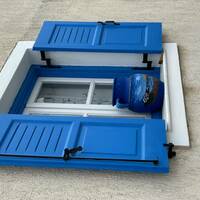 Jen
Jen This transcription item is now locked to you for editing. To release the lock either Save your changes or Cancel.
This lock will be automatically released after 60 minutes of inactivity.